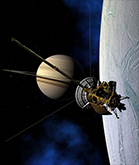2024 Speakers
The Terence Dickinson Memorial Keynote Speaker
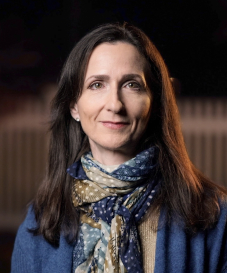
Dr. Sara Seager
Sponsored by Khan Scope Centre
Planetary Atmospheres and the Search for Signs of Life Beyond Earth
For thousands of years, inspired by the star-filled dark night sky, people have wondered what lies beyond Earth. Today, the search for signs of life is a key motivator in exoplanet research. With exquisite data from the successfully operational James Webb Space Telescope, we are now confronted with new, practical challenges of tiny signals, unknown exoplanet environments, and host star contamination. Our pace and history of milestone discovery in exoplanets in the last quarter century, combined with new telescope paradigms, promises to eventually deliver on finding signs of life beyond Earth.
Biography:
Professor Sara Seager is a Canadian-American astrophysicist and planetary scientist. Born and raised in Toronto, she is a professor at the Massachusetts Institute of Technology (MIT). Seager's work focuses on exoplanet atmospheres and methods for detecting signs of extraterrestrial life. She has significantly contributed to the field of exoplanet research, particularly in theoretical modeling of atmospheric composition and the development of novel methods for exoplanet detection. She was the Deputy Science Director of the MIT-led NASA Explorer-class mission TESS; PI of the JPL-MIT CubeSat ASTERIA; and a lead of the Starshade mission concepts. She also focuses on missions to Venus. Her innovative approaches have earned her numerous awards and recognition including a MacArthur Fellowship, membership in the US National Academy of Sciences, an appointment as an Officer of the Order of Canada, the Royal Canadian Geographical Society Gold Medal, and she has Asteroid 9729 named in her honor. Professor Seager is the RASC Honorary President and is author of, “The Smallest Lights in the Universe: A Memoir.”
Keynote Speakers (alphabetically):

Dr. Michael Daly
Sponsored by Astronomy Plus
Canada and Asteroid 101955 Bennu
We will discover the story of Canada’s involvement in the historic NASA OSIRIS-REx mission to asteroid 101955 Bennu. With a story that starts with a previous mission, and with trials and tribulations along the way, Canada contributed an amazing instrument that provided an unprecedented view of this near-Earth asteroid and supported the amazing accomplishment of bringing a pristine sample of this asteroid back to Earth in September of 2023. Although the space phase of this mission is over, many discoveries await. All the mission data is available to the international science community (and the public) for further work. Studies of this material from Bennu and plans for caring for Canada’s portion are underway. Finally, from OSIRIS-REx, a new mission to asteroid 99942 Apophis is underway as OSIRIS-APEX.
Biography:
Dr. Michael Daly is a professor in the Department of Earth and Space Science and Engineering (ESSE) at York University and holds the York University Research Chair in Planetary Science. Mike also serves as the Director of the Centre for Research in Earth and Space Science (CRESS) which is an organized research unit of the university. After initiating the Canadian involvement in the NASA Phoenix Mars Mission, he served as the Chief Engineer for this project. In a similar way, he initiated Canada’s involvement in the OSIRIS-REx mission with the OSIRIS-REx Laser Altimeter (OLA) and led the scientific investigations with the instrument. Dr. Daly was honoured to receive the Canadian Aeronautics and Space Institute’s 2018 McCurdy Award for outstanding achievement in the science and creative aspects of engineering relating to aeronautics and space research.
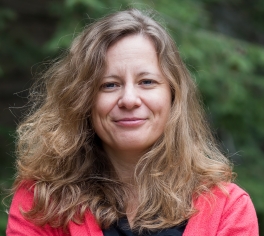
Dr. Els Peeters
Illuminating Orion’s Bar with JWST
Canadian astronomers have front-row seats to the spectacular new science that is being revealed by the James Webb Space Telescope (JWST) – from the smallest scales such as solar system bodies or exoplanets to the scale of distant galaxies and the structure of the Universe. This new science is the result of JWST being bigger and vastly more sensitive than the Hubble Space Telescope, and of JWST having infrared vision that allows us to peer through the dust that obscures many astrophysical processes at optical wavelengths. I will focus in particular on the breathtaking JWST observations of the Orion nebula, the nearest massive stellar nursery. With these observations, we can directly observe and study the interaction of young stars with their natal cloud. I will show how JWST allows us to study the physical processes that affect star and planet formation in groundbreaking new ways.
Biography:
Els Peeters is an astrophysicist at Western University. She holds an M.Sc. degree in Physics from the Catholic University of Leuven and a European M.Sc. degree in Astronomy and Astrophysics. She obtained her Ph.D. in Astronomy at the University of Groningen in the Netherlands. She then spent several years at the NASA Ames Research Center and the SETI Institute before becoming professor in the department of Physics and Astronomy and the Institute for Earth and Space Exploration at the University of Western Ontario. Her research focuses on star formation and interstellar gas and dust in the Milky Way and nearby galaxies. She is leading the JWST Early Release Science Program “PDRs4All: Radiative Feedback from massive stars” with Dr. Berné and Prof. Habart.
Guest Speakers (alphabetically):
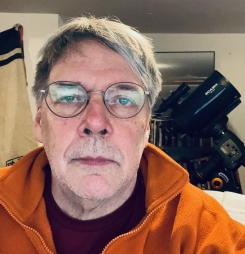
Andy Beaton
The Sky Tonight
“I’ve looked at the Moon and Saturn. Now what?” Is this you? It’s a question I get asked a lot with people who are new to astronomy, or have just shown up for an evening’s observing without a spreadsheet of all their planned observations. I’ll be talking about what we can see in the sky tonight, leaning towards the less experienced audience but throwing in a few treats for the more seasoned observers. Some of the topics will be specific for tonight, others can be taken away for future clear skies, just in case the clouds are not kind to us. Will you be observing with the good old Mark I eyeball, or a telescope you need a ladder to use? There should be something here for you to take into tonight's sky.
Biography:
Andy has been a dedicated amateur astronomer since he was 10, when his grandmother gave him a map of the universe for his birthday. Although a degree in astrophysics from U of Toronto did not lead to a career in astronomy, it did lead to a desire to do more in astronomy than observe for pleasure and into the exciting world of variable star measurement.
It also left him with a wealth of astronomical knowledge and a willingness to share it, leading to an active role in outreach and presentations at the RASC. His semi-regular Sky This Month talks are the logical end of his desire to talk about astronomy to anyone who will listen.
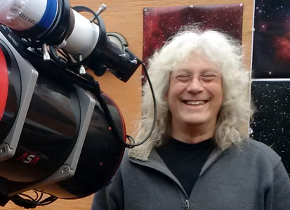
Dr. Ron Brecher
Four Metres and Counting
For the last year, Ron has been using a 14” Celestron Edge HD telescope for deep-sky imaging. With a whopping 3,912 mm focal length, this light bucket can pull in some deep-sky targets that appear very small on the sky. What’s more, despite having a “slow” f/11 focal ratio, this telescope seems to accumulate photons very quickly using the latest CMOS cameras, which are both highly efficient and sensitive.
In this presentation, Ron will show you some of the strange and fascinating objects revealed by this 4m focal length imaging system. He’ll also talk about some of the challenges of using this system in a backyard observatory just an hour from Starfest.
Biography:
Ron Brecher has been an avid amateur astronomer for more than 25 years and began photographing the sky in 2004. Ron is a Contributing Editor for Sky & Telescope magazine and writes for several other publications. His deep-sky, Sun and Moon images and articles are regularly featured in books, magazines, scientific journals, calendars and more.
Ron uses PixInsight for processing his deep-sky shots. He offers private tutoring, workshops, and video tutorials online. Ron is a regular speaker at star parties and conferences in the U.S. and Canada.
Ron images from his home observatory in Guelph, Ontario where he and his wife Gail live with a dog, two cats, their daughter and her partner. In “real life,” Ron holds a PhD and is a board-certified toxicologist with more than 35 years’ consulting experience in toxicology, risk assessment and risk communication. To round things out, Ron plays guitar and lead vocals in the R&B Band “The Exceptions.”
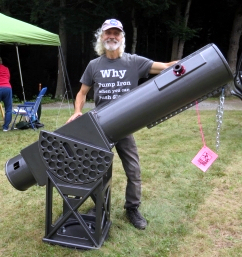
Clay Davies
How to Build a "Planet Killer" - and How it Might Help Save the Earth
For decades, a group of telescope makers and avid planetary observers engaged in "friendly competition" to see who could buy or build the best telescope for planets. They tried everything. Contenders included big premium dobs and big refractors, including a 10"f/16 Zeiss apochromatic refractor. Remarkably, these fine instruments were all beaten by an ugly little 11.75"f/6.4 Newtonian with strange design features. Award winning telescope maker Clay Davies will show you how to build such a simple yet remarkable planetary telescope. He will also reveal "dirty little secrets" for making an excellent mirror on your first try, telescope hacks for commercial Newtonians; and weird and counterintuitive yet effective planetary observing tips you've never heard before.
Biography:
Clay Davies has been fascinated with space and astronomy since he was five years old, when he saw the Milky Way for the first time. He is a visual observer. He loves to share the view at outreach events. In the past twenty years he has built many telescopes of different designs optimized for different purposes, and he has been making mirrors for the past five years. He was awarded the 2016 Jesse Ketchum Award for Astromical Equipment by the RASC Toronto Centre, and was featured in a Sky News magazine article entitled The Modern Makers. Apart from occasional dark sky excursions, he enjoys observing bright objects, especially planets, from his urban balcony or a local park, and hosting impromptu star parties on his urban rooftop.
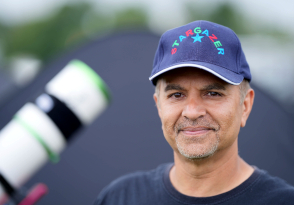
Dr. David Dev
Moving from Good to Better : 10 insights to elevate your astrophotography
With today’s hardware and software, its not difficult to produce “good” astrophotos. Amateur photos now rival NASA’s results from previous years. But is that good enough anymore? Can we do better than “good”?
Astrophotographers are an obsessive lot, disturbed to the core, and for most of us, good is not good enough. We want better stars, colour, detail, guiding, gear etc. Those of us that enter imaging contests want our photos to rise above the sea of entries & capture the hearts of judges. How can we get there? Spend more money? More time? More courses?
Over the last 10 years, through serendipity, failures and things that can’t be unseen, Dave stumbled across a number of ways to up the game. Going from good to better is not an easy journey but it can be expedited if a multifactorial approach is taken. 10 practical insights will be shared and you will leave with tangible ideas to improve your results & catch the eye of judges. None of these tips were generated by ChatGPT. Buckle up. Let’s go for a ride.
Biography:
As a physician Dave loves his profession and considers it the best job in the world. However, he won’t let it interfere with his calling : imaging. Astrophotography is the zen that captures, cuts through & clarifies. As a long time member of the NYAA, Dave is indebted to club members and the Starfest committee for their tireless promotion and support of all things Imaging.
Dave has been the Director of the Starfest Imaging Contest for a decade and considers it the 2nd best job in the world. He is passionate about bringing the craft to everyone and honoring those that create photon magic. Dave’s images have won awards on Astrobin and AAPOD, as well as being highlighted in various Astro publications and national calendars.
On occasion he uploads his photos as screensavers in Best Buy stores. In pursuit of perfection, Dave has been known to buy and sell gear. A lot. Sometimes on the same day.
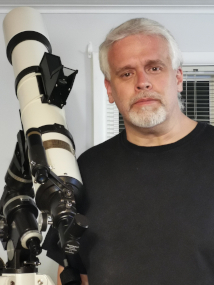
Marc Fitkin
Astronomy 101: Starting out right in Astronomy
Astronomy 101 will help the beginner astronomer navigate through equipment and literature to start them right in astronomy with the hope of cultivating a lifelong passion of the night sky. The presentation will be a mixture of lecture style and audience participation to help grow that passion.
Biography:
Marc's interest in astronomy began in his childhood as a result of a combination of the Space Shuttle Program, exposure to dark skies in Muskoka, and the film 2001: A Space Odyssey. For over 30 years, he has been enjoying nights with various telescopes and binoculars and worked in the astronomy and birding retail for over ten years. In 2019, Marc along with his wife and best friend Karen O'Kapiec-Fitkin began to look at starting a local astronomy meet up in their local village of Bronte in Oakville, Ontario. But like everything else, the world paused for the pandemic. In 2022, recognizing an opportunity and a village starving for community, Marc and Karen started The Bronte Astronomer, an informal meet up and community with public astronomy nights and an online community on Facebook with the intention of bringing astronomy to everyone in the local area and supporting existing astronomy clubs and associations.
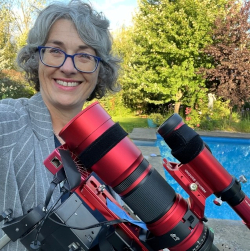
Andrea Girones
Solar imaging tools and tips in 2024
Solar imaging is experiencing a great renaissance in terms of interest and processing software thanks to the imminent arrival of solar maximum in 2024-2025. The active time, full of sunspots and flares has made solar imaging more exciting than ever.
In this presentation Andrea hopes to de-mystify solar imaging and encourage others to try it. Solar imaging is fast and usually warm and does not affect your sleep (although creating a nice timelapse may keep you up at night). Andrea will talk about her equipment, imaging techniques and discuss about some of the great new solar processing software now available to us.
Biography:
Andrea Girones is clearly obsessed with her astrophotography. A life-long astronomer and eclipse chaser (she used to take sky pictures with film back in the day) it took a while for Andrea to figure out these new-fangled automated scopes and digital cameras. After a long hiatus from the hobby raising her two children it was Comet Neowise that brought her back to her beloved hobby. Thankfully by this time her daughter could help her work her modern DLSR digital camera and together during the pandemic they took her first digital image of that famous Comet.
Since then Andrea has spent much time, effort (and disposable income) refining her art. Her astrophotography has won several awards, including the Paul Commission Observer of the Year award, the Rolf Meir Planetary imager of the year, of her local RASC chapter, a WITNS selection from Alyn Wallace, as well as the Williamina Fleming award from the Astronomical League. She was honoured to have been selected as the Starfest 2023 Imager of the Year.
Her images have appeared on the covers of the Journal of the Royal Astronomical Society of Canada and on the cover of the 2024 RASC calendar. She often give presentations to organizations on solar imaging, a particular fascination for her.
Her work is on Instagram, Astrobin and Flickr.
Andrea lives and images from Ottawa Ontario Canada.
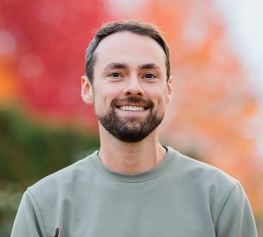
Trevor Jones
An Introduction to Deep-sky Astrophotography
Trevor Jones, from AstroBackyard, will describe his process of photographing stunning deep-sky objects, like galaxies and nebulae, from his own backyard. From building a beginner-level astrophotography kit to image processing tips and tricks, this presentation will open your eyes to what is now possible using amateur equipment. His simplistic approach will help you avoid the frustration and confusion many astrophotography beginners face, and set you on a path to success.
Biography:
Trevor Jones is a full-time astrophotographer and content creator sharing his 10+ years of knowledge and experience on his popular website and YouTube channel, AstroBackyard. With a background in graphic design and marketing, his videos reach nearly half a million YouTube subscribers, providing beginners with equipment options, image acquisition tools, and image processing techniques. Trevor’s involvement in astrophotography extends to the greater community as a photography contest judge, dark-sky advocate, and public speaker. He is especially passionate about making this hobby more accessible (and fun) to those who are new to their astro journey.
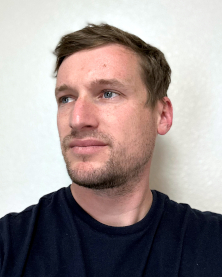
Kevin LeGore
Napkin to Reality
Bringing a new astronomy product can be a fairly challenging process. Not every idea that comes to mind makes it to the final price list. Kevin LeGore, Senior Product Specialist for Sky-Watcher takes us through the process of developing a product. This presentation is a unique interactive talk taking ideas from the group and working through the development process. Covering the positives and negatives that may occur when working with a new idea and bringing it to market.
Biography:
Kevin LeGore has been with Sky-Watcher North America as Product Specialist for over 10 years. He has assisted in the development of several popular products including the Evostar 150ED and DX apos, the Quattro 150P newtonian and many more. Kevin is an avid astronomer and astrophotographer and has been in the hobby since the age of 9. He enjoys observing deep sky targets with large dobs, night vision astronomy and solar observing.
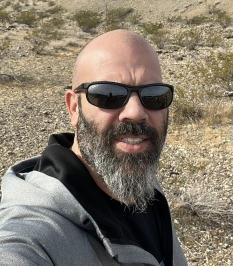
Steve Mallia
The effects of AI that influence equipment present and future. A Discussion.
Technology is rapidly changing the landscape for amateur astronomers. With the advent of AI in the mainstream, what was once tedious tasks and now simple clicks do a mouse. Data that was once considered sub par is completely usable. Does this now introduce to the hobby “the lazy astronomer” or create opportunities for manufacturers to innovate? We will turn these questions into a discussion that attempt to answer those questions.
Biography:
Steve Mallia, founder of the Ontario Telescope and Starfield Optics, had been involved in the astronomy industry in various capacities for the past 15 years which included consulting, sales and manufacturing. A graduate of Humber College Electronics Technology program. Always looking for the next innovation to get behind, and the next moonless dark sky. When not trying to image, emphasis on trying, Steve is tinkering with one of his many, refrigerator sized, 3D printers, or scouring Marketplace for some rare find. A regular at several astronomy trade shows, and industry events. Steve lives in Bolton with his wife Natalie and two teenage sons. One day he will have a dog named Louis.

Wayne Parker
Assembling a POD-S
Come and meet Wayne and the SkyShed team! Spend some quality time and ask questions as you watch a POD-S being built near the main tent. Pull up a chair and watch the assembly of a beautiful POD-S being filmed. (Tuesday until Thursday. Then on display for the rest of Starfest).
Biography:
Wayne Parker is a 5-time Juno Award winner and Grammy nominee, and founding member of the iconic Canadian rock band Glass Tiger who have recently been inducted into Canada's Walk of Fame.
He is currently on a sabbatical from the band in order to focus on SkyShed Observatories. Wayne is the designer, and he and his wife Lorelei are the owners of SkyShed Observatories. A proud Canadian observatory maker.
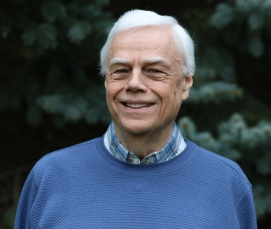
Bob Sandness
Asteroid Hunting - Past, Present and Future
Amateurs have played a significant role in asteroid discovery, starting with the first amateur discovery in 1845. Over the years visual searches have given way to searches using photographic and CCD/CMOS imagers. While professional surveys have squeezed out a lot of amateur discovery opportunities, advanced GPU driven programs like Tycho have opened up new possibilities for amateur asteroid hunters. The talk will explain how you too can become an asteroid hunter and get your own observatory code. It will also look at the future developments as the new LSTT telescope comes online next year.
Biography:
Bob bought his first telescope (Tasco 60mm) at the age of 11 and has been involved in astronomy ever since. He has discovered six new asteroids using his C14 backyard telescope. He named the first of these in honour of his wife Susanne. Given Ontario skies are not always astro friendly, Bob has an observatory with a 17" telescope in the Chilean Atacama desert. In 2013 he was part of the ProAm team that discovered the first asteroid (Chariklo 10199) that had a set of rings. More recently, he worked with Alain Maury (SPACE Atacama) to capture images of the after effects of the NASA DART impact on the asteroid moon Dimorphos. Bob has also built his own 6 and 12" telescopes and likes to explore aspects of radio astronomy, especially hydrogen line and solar flare reception. His astro images have been published in books, magazines and shown on TV programs.
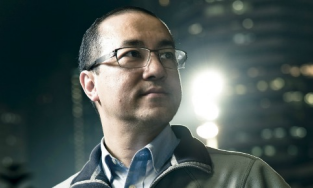
Bill Yeung
Amateur Astronomers Can Still Make New Discoveries in the Era of JWST
Astronomy is said to be one of those rare fields in science that amateur could still make contribution with new discoveries. Yet with the advance of powerful telescope like the JWST, the role which amateur astronomers could play seems to be diminishing. The speaker begs to differ. With the right knowledge and skill, amateur could still contribute meaningful astronomical observations by being at the right place at the right time. This talk would cover the basic and importance of asteroid occultation, also how three RASC Calgary center amateurs detected the binary nature of asteroid 5232 during a Feb. 1 occultation.
Biography:
Bill Yeung is a dedicated astronomer and former president of the Hong Kong Astronomical Society. During his 7-year term in Arizona from 2000 to 2007, Bill discovered over 2,000 new asteroids and 2 comets. He is also the discoverer of the third stage of the Apollo 12 Saturn V rocket which left earths orbit to be recaptured three decades later as a temporary Earth satellite (J002E3), which was initially thought to be a second moon. After returning to Canada in 2021, Bill reignited his passion for astronomy, focusing on asteroid occultations and becoming a "shadow chaser". Learn more about Bill's achievements on his Wikipedia page.
Chasing The Shadow Panel Discussion
Where were you on April 8, 2024 for the Great North American Total Solar Eclipse? Were you able to see it from your backyard or did you have to make a last-minute dash to see the eclipse from a location that had clear skies? In this panel discussion, lead by Dave Cotterell, we will hear about the adventures of four eclipse chasers who travelled to various locations to see and image the eclipse. Dave Cotterell will begin with his village crawl eastward to Quebec. This will be followed by Malcom Park’s visit to the shores of Lac-Mégantic and Charles Darrow’s adventure on the east coast in Fredericton, New Brunswick. Rounding out the panel will be Andreas Gada with his epic journey to the River Bluff Cabins near Leakey Texas.
Panel Members:

Dave Cotterell
I received my first telescope in 1960 and have been looking up ever since. I have always preferred visual observing, especially double stars and planetary. I have viewed three solar eclipses, 2008, 2017 and 2024, in gloriously clear skies.
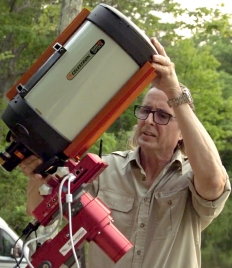
Charles Darrow
Charles is the past President of the RASC, Toronto Centre. His interest in Space and Astronomy was sparked by the Apollo moon landings, dark skies at the family cottage near Wasaga Beach and his dad bringing home a Vixen telescope from a business trip to Japan in the early 70s. He is a casual astro-imager and eclipse chaser. He is featured in the Emmy winning documentary about the James Webb Space Telescope, "The Hunt for Planet B"
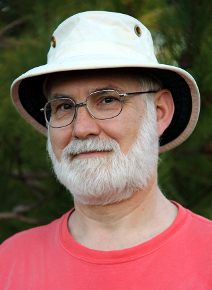
Andreas Gada
Andreas Gada is one of the founders, and a Past President of the North York Astronomical Association. In 1982, he started Starfest, and was the head ‘honcho’ for twenty-six years. He is an avid astrophotographer and telescope maker who enjoys puttering in his machine shop. In 1979, he saw and imaged his first Total Solar Eclipse. Since then he has traveled to many exotic places to photograph total solar eclipses. Some of his images have won awards and have been published in various astronomy magazines (Sky and Telescope, Astronomy magazine, SkyNews), textbooks, and used in an award-winning documentary entitled “Hooked On The Shadow”. Recently, his time-lapse videos of the 2012 eclipse were used in the Cosmic Vistas episode on Eclipses.
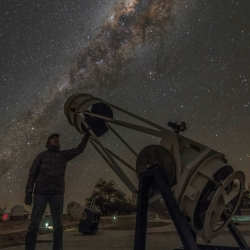
Malcolm Park
Malcolm Park is a Canadian amateur astronomer and astrophotographer from the Kingston area, originally from Toronto. Malcolm has held various positions in the executives of the North York Astronomical Association and Starfest Committee, and the Kingston Centre of the RASC. After over 30 years in the banking industry, Malcolm retired in 2014 to pursue his passion for astronomy with a backyard observatory north of Kingston ON, and a remote telescope hosted in San Pedro de Atacama, Chile.
